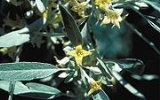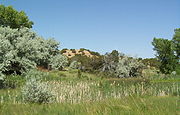
Elaeagnus angustifolia
Encyclopedia
Elaeagnus angustifolia, commonly called silver berry, oleaster, Russian olive, or wild olive, is a species of Elaeagnus
, native to western and central Asia
, from southern Russia
and Kazakhstan
to Turkey
and Iran
. It is now also widely established in North America
as an introduced species
.
Elaeagnus angustifolia is a usually thorny shrub
or small tree
growing to 5–7 m in height. Its stems, buds, and leaves have a dense covering of silvery to rusty scales. The leaves
are alternate, lanceolate, 4–9 cm long and 1-2.5 cm broad, with a smooth margin. The highly aromatic flower
s, produced in clusters of 1-3, are 1 cm long with a four-lobed creamy yellow corolla; they appear in early summer and are followed by clusters of fruit
, a small cherry-like drupe
1-1.7 cm long, orange-red covered in silvery scales. The fruits are edible and sweet, though with a dryish, mealy texture. Its common name comes from its similarity in appearance to the olive
(Olea europaea), in a different botanical family
, Oleaceae
.
The shrub can fix nitrogen
in its roots, enabling it to grow on bare mineral substrates.
The dried powder of the fruits are used mixed with milk in Iran for rheumatoid arthritis and joint pains. It is also one of the seven items which are used in Haft Sin or the seven 'S's which is a traditional table setting of Nowruz
, the traditional Persian spring celebration.
 Elaeagnus angustifolia was described as Zizyphus cappadocica by John Gerard
Elaeagnus angustifolia was described as Zizyphus cappadocica by John Gerard
, was certainly grown by John Parkinson
by 1633, and was being grown in Germany
in 1736. It is now widely grown across southern and central Europe
as a drought-resistant ornamental plant
for its scented flowers, edible fruit, attractive silver foliage, and black bark.
The species was introduced into North America
in the late 19th century, and subsequently escaped cultivation, because its fruits, which seldom ripen in England
, are relished by birds which disperse the seeds
. Russian-olive is considered to be an invasive species
in many places in the United States
because it thrives on poor soil, has low seedling mortality rates, matures in a few years, and outcompetes wild native vegetation. It often invades riparian habitats where overstory cottonwoods have died.
Elaeagnus
Elaeagnus , silverberry or oleaster, is a genus of about 50–70 species of flowering plants in the family Elaeagnaceae.The vast majority of the species are native to temperate and subtropical regions of Asia. Elaeagnus triflora extends from Asia south into northeastern Australia, while E...
, native to western and central Asia
Asia
Asia is the world's largest and most populous continent, located primarily in the eastern and northern hemispheres. It covers 8.7% of the Earth's total surface area and with approximately 3.879 billion people, it hosts 60% of the world's current human population...
, from southern Russia
Russia
Russia or , officially known as both Russia and the Russian Federation , is a country in northern Eurasia. It is a federal semi-presidential republic, comprising 83 federal subjects...
and Kazakhstan
Kazakhstan
Kazakhstan , officially the Republic of Kazakhstan, is a transcontinental country in Central Asia and Eastern Europe. Ranked as the ninth largest country in the world, it is also the world's largest landlocked country; its territory of is greater than Western Europe...
to Turkey
Turkey
Turkey , known officially as the Republic of Turkey , is a Eurasian country located in Western Asia and in East Thrace in Southeastern Europe...
and Iran
Iran
Iran , officially the Islamic Republic of Iran , is a country in Southern and Western Asia. The name "Iran" has been in use natively since the Sassanian era and came into use internationally in 1935, before which the country was known to the Western world as Persia...
. It is now also widely established in North America
North America
North America is a continent wholly within the Northern Hemisphere and almost wholly within the Western Hemisphere. It is also considered a northern subcontinent of the Americas...
as an introduced species
Introduced species
An introduced species — or neozoon, alien, exotic, non-indigenous, or non-native species, or simply an introduction, is a species living outside its indigenous or native distributional range, and has arrived in an ecosystem or plant community by human activity, either deliberate or accidental...
.
Elaeagnus angustifolia is a usually thorny shrub
Shrub
A shrub or bush is distinguished from a tree by its multiple stems and shorter height, usually under 5–6 m tall. A large number of plants may become either shrubs or trees, depending on the growing conditions they experience...
or small tree
Tree
A tree is a perennial woody plant. It is most often defined as a woody plant that has many secondary branches supported clear of the ground on a single main stem or trunk with clear apical dominance. A minimum height specification at maturity is cited by some authors, varying from 3 m to...
growing to 5–7 m in height. Its stems, buds, and leaves have a dense covering of silvery to rusty scales. The leaves
Leaf
A leaf is an organ of a vascular plant, as defined in botanical terms, and in particular in plant morphology. Foliage is a mass noun that refers to leaves as a feature of plants....
are alternate, lanceolate, 4–9 cm long and 1-2.5 cm broad, with a smooth margin. The highly aromatic flower
Flower
A flower, sometimes known as a bloom or blossom, is the reproductive structure found in flowering plants . The biological function of a flower is to effect reproduction, usually by providing a mechanism for the union of sperm with eggs...
s, produced in clusters of 1-3, are 1 cm long with a four-lobed creamy yellow corolla; they appear in early summer and are followed by clusters of fruit
Fruit
In broad terms, a fruit is a structure of a plant that contains its seeds.The term has different meanings dependent on context. In non-technical usage, such as food preparation, fruit normally means the fleshy seed-associated structures of certain plants that are sweet and edible in the raw state,...
, a small cherry-like drupe
Drupe
In botany, a drupe is a fruit in which an outer fleshy part surrounds a shell of hardened endocarp with a seed inside. These fruits develop from a single carpel, and mostly from flowers with superior ovaries...
1-1.7 cm long, orange-red covered in silvery scales. The fruits are edible and sweet, though with a dryish, mealy texture. Its common name comes from its similarity in appearance to the olive
Olive
The olive , Olea europaea), is a species of a small tree in the family Oleaceae, native to the coastal areas of the eastern Mediterranean Basin as well as northern Iran at the south end of the Caspian Sea.Its fruit, also called the olive, is of major agricultural importance in the...
(Olea europaea), in a different botanical family
Family (biology)
In biological classification, family is* a taxonomic rank. Other well-known ranks are life, domain, kingdom, phylum, class, order, genus, and species, with family fitting between order and genus. As for the other well-known ranks, there is the option of an immediately lower rank, indicated by the...
, Oleaceae
Oleaceae
Oleaceae are a family containing 24 extant genera and around 600 species of mesophytic shrubs, trees and occasionally vines. As shrubs, members of this family may be twine climbers, or scramblers.-Leaves:...
.
The shrub can fix nitrogen
Nitrogen fixation
Nitrogen fixation is the natural process, either biological or abiotic, by which nitrogen in the atmosphere is converted into ammonia . This process is essential for life because fixed nitrogen is required to biosynthesize the basic building blocks of life, e.g., nucleotides for DNA and RNA and...
in its roots, enabling it to grow on bare mineral substrates.
The dried powder of the fruits are used mixed with milk in Iran for rheumatoid arthritis and joint pains. It is also one of the seven items which are used in Haft Sin or the seven 'S's which is a traditional table setting of Nowruz
Nowruz
Nowrūz is the name of the Iranian New Year in Iranian calendars and the corresponding traditional celebrations. Nowruz is also widely referred to as the Persian New Year....
, the traditional Persian spring celebration.
Cultivation and invasiveness

John Gerard
John Gerard aka John Gerarde was an English herbalist notable for his herbal garden and botany writing. In 1597 he published a large and heavily illustrated "Herball, or Generall Historie of Plantes", which went on to be the most widely circulated botany book in English in the 17th century...
, was certainly grown by John Parkinson
John Parkinson
John Parkinson may refer to:*John Parkinson , English herbalist*John B. Parkinson , American architect in Los Angeles*John Parkinson , British Labour Party MP for Wigan, 1918–1941...
by 1633, and was being grown in Germany
Germany
Germany , officially the Federal Republic of Germany , is a federal parliamentary republic in Europe. The country consists of 16 states while the capital and largest city is Berlin. Germany covers an area of 357,021 km2 and has a largely temperate seasonal climate...
in 1736. It is now widely grown across southern and central Europe
Europe
Europe is, by convention, one of the world's seven continents. Comprising the westernmost peninsula of Eurasia, Europe is generally 'divided' from Asia to its east by the watershed divides of the Ural and Caucasus Mountains, the Ural River, the Caspian and Black Seas, and the waterways connecting...
as a drought-resistant ornamental plant
Ornamental plant
Ornamental plants are plants that are grown for decorative purposes in gardens and landscape design projects, as house plants, for cut flowers and specimen display...
for its scented flowers, edible fruit, attractive silver foliage, and black bark.
The species was introduced into North America
North America
North America is a continent wholly within the Northern Hemisphere and almost wholly within the Western Hemisphere. It is also considered a northern subcontinent of the Americas...
in the late 19th century, and subsequently escaped cultivation, because its fruits, which seldom ripen in England
England
England is a country that is part of the United Kingdom. It shares land borders with Scotland to the north and Wales to the west; the Irish Sea is to the north west, the Celtic Sea to the south west, with the North Sea to the east and the English Channel to the south separating it from continental...
, are relished by birds which disperse the seeds
SEEDS
SEEDS is a voluntary organisation registered under the Societies Act of India....
. Russian-olive is considered to be an invasive species
Invasive species
"Invasive species", or invasive exotics, is a nomenclature term and categorization phrase used for flora and fauna, and for specific restoration-preservation processes in native habitats, with several definitions....
in many places in the United States
United States
The United States of America is a federal constitutional republic comprising fifty states and a federal district...
because it thrives on poor soil, has low seedling mortality rates, matures in a few years, and outcompetes wild native vegetation. It often invades riparian habitats where overstory cottonwoods have died.
Propagation
Establishment and reproduction of Elaeagnus angustifolia is primarily by seed, although some spread by vegetative propagation also occurs. The fruit is readily eaten and disseminated by many species of birds. The plants begin to flower and fruit from three years old.External links
- Jepson Manual Treatment
- Species Profile - Russian Olive (Elaeagnus angustifolia), National Invasive Species Information Center, United States National Agricultural LibraryUnited States National Agricultural LibraryThe United States National Agricultural Library is one of the world's largest agricultural research libraries, and serves as a National Library of the United States and as the library of the United States Department of Agriculture...
. Lists general information and resources for Russian Olive. - USDA Plants Profile
- Photo gallery

